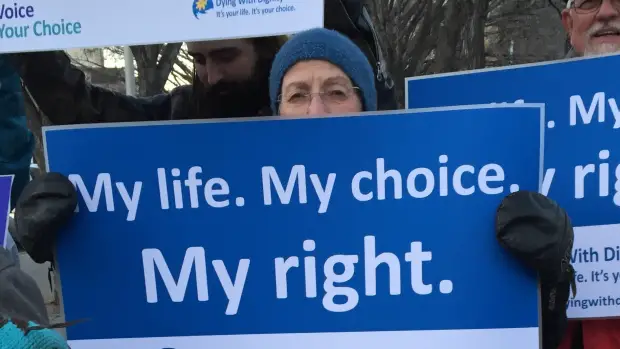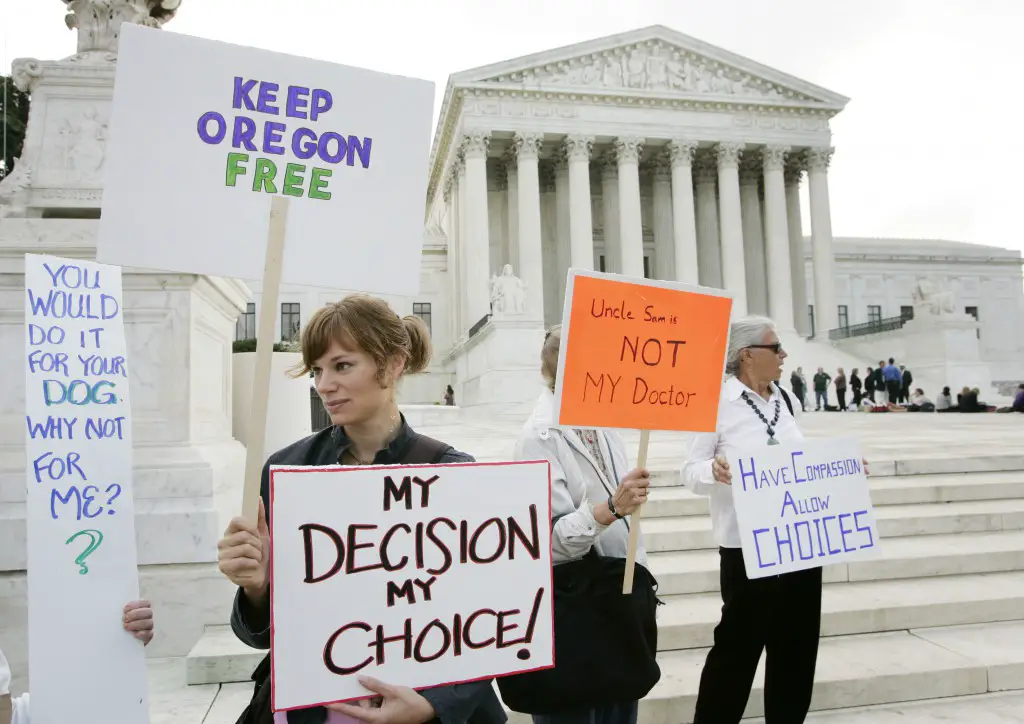Death with Dignity Comes to the Rockies
In a November vote to approve physician-assisted suicide, Colorado joined the growing number of states permitting the practice.
By Jonathan Kim, University of Texas at Dallas
On November 8, when the nation was scampering to cast its 2016 presidential ballot, the residents of Colorado also voted on a bonus referendum: Should Colorado pass Proposition 106 to legalize physician-assisted suicide?
Colorado residents voted overwhelmingly in the affirmative, with 65 percent in favor of the proposition. By the end of Election Day, Colorado had become the sixth state (after Oregon, Washington, California, Montana and Vermont) to legalize physician-assisted suicide in cases in which the patient is terminally ill and mentally competent.
Proposition 106, which is modeled after Oregon’s Death with Dignity Act, makes clear in its stringent codes how the assisted death must take place. Two doctors must agree that the patient has fewer than six months to live, which disqualifies those with chronic but non-fatal disabilities. The patient must be over 18 years of age, mentally competent and must knowingly self-administer a lethal dose of the prescribed secobarbital.

(In the 1999 cause célèbre, Dr. Jack Kevorkian, dubbed the “Angel of Death and “Dr. Death,” assisted the suicide of Thomas Youk, a Detroit man with Lou Gehrig’s disease, by lethal injection. Authorities did not prosecute Kevorkian at the time of the perpetration. But Kevorkian, by his own fancy, decided to videotape himself injecting Youk and sent the tape to the CBS news program “60 Minutes.” He was shortly found guilty of second-degree murder.)
In the U.S., the most recent surge of public interest on the “right to die” issue, which includes euthanasia and assisted suicide, began with the 1977 New Jersey case of Karen Ann Quinlan.
A few days after her 21st birthday, Quinlan went to a party, took diazepam (Valium) and drank alcohol, all while on a radical diet, and consequently fell into a coma. She lapsed into a vegetative state that persisted for ten years. Her parents pleaded with the doctor to remove Quinlan’s life-saving ventilator, but the doctor refused in fear of a murder charge. Quinlan’s parents eventually appealed to the New Jersey Supreme Court, who permitted the removal of the ventilator.
The Quinlan case was a legal landmark and attracted worldwide attention, but was ruled by a state supreme court. The U.S. Supreme Court first heard its own “right to die” case in “Cruzan v. Director, Missouri Department of Health (1990).” In 1983, Nancy Cruzan lost control of her car, was thrown out of the window and landed in a water-filled ditch. Cruzan fell into a coma and was later diagnosed with persistent vegetative state. Only a feeding tube kept her alive.
Her parents, for reasons similar to Quinlan’s, wanted the feeding tube removed. They eventually appealed to the U.S. Supreme Court, who, in a split 5-4 decision, held that the 14th Amendment protects the right of an individual to refuse life-saving treatment.
In cases involving an incompetent individual, although the refusal of treatment is permitted, states have power to impose their requirements for surrogacy and establish their own standard of what constitutes as “clear and convincing” evidence that the patient wanted to die.
The Quinlan and Cruzan cases regard passive and non-voluntary euthanasia, but not assisted suicide. In 1997, the U.S. Supreme Court decided, on the same day, two cases that involved physician-assisted suicide: “Washington v. Glucksberg (1997)” and “Vacco v. Quill (1997).” Although “Vacco” is considered the landmark case (according to Wikipedia), the Court held the same rationale in both; the right to suicide, and thus assisted suicide, is not fundamental, and so is not protected by the Constitution.
Since the Court could neither ban nor approve aid in dying, the issue turned over to the states, with Oregon becoming the first to legalize physician-assisted suicide, marketing it as “death with dignity,” only a few months after the Court’s decision in 1997.

More states have since passed similar bills, and the issue is only gaining traction. According to the Death with Dignity National Center, 19 states, including Alaska and Hawaii, are currently working to enact legislation for physician-assisted suicide. (Not surprisingly, most states with no current legislative activity tend to be conservative. My state of Texas is no exception. In fact, it has never even tried.)
Hawaii began its efforts almost two decades ago, in 1998, though its most recent 2016 hearing failed to meet deadline. But the prospects seem bright for assisted dying in Hawaii; in a 2016 poll, 80 percent of Hawaiians believe that a “death with dignity” option should at least be made available for those who find no palatable alternative.
This option for the terminally ill to opt out of hopeless suffering should be motive enough for state legislation. Otherwise, many victims of forlorn torment resort to suicide by means more violent, usually purposeful starvation or dehydration. There is even a nurse in New York who coaches people through death by starvation since her state does not yet permit a physician’s aid in dying.
Granted, many of the cases that involve intentional death by starvation or dehydration would not qualify anyway as operating under a “terminal illness.” But, without the option to decide a peaceful end to one’s fate, those who are terminally ill and live by happenstance in any of the 44 passive states will be denied a safe and humane option to pass into the afterlife; without sanction from the state, those who would have qualified under Colorado’s Prop 106, and whose only sin is their location of residence, will be forced to explore other suicidal means that could be inhumane, ineffective and more painful.
The countervailing forces to assisted dying are usually from religious groups, especially Catholics, whose casuistries in argument against the “right to die” are more or less scions of their religious dogmas. But there is reason as to why, according to a 2016 Gallup poll, the “right to die” hits a chord with 69 percent of Americans.
Inherent in our right to live is the right to decide what makes our life worth living, and thus the right to decide when our life is not worth living. Are we not the most qualified arbiters of the quality of our own lives? And if it’s true that our right to die inheres in part to our right to live, do we also have the right to die in peace? The right to die with dignity?










What else have they lied about for convenience?
Correction please: Here is the rest of the story.
Your source has done you a disservice. The promoters of assisted suicide have worn out their thesaurus attempting to imply that it is legal in Montana. Assisted suicide is a homicide in Montana. Our MT Supreme Court did ruled that if a doctor is charged with a homicide they might have a potential defense based on consent. The MT Supreme Court acknowledged it is a homicide in the ruling.
The Court did not address civil liabilities and they vacated the lower court’s claim that it was a constitutional right. Unlike Oregon no one in Montana has immunity from civil or criminal prosecution, death certificates are not legally falsified and investigations are not prohibited like in OR, WA and CA. Does that sound legal to you? Does that sound shielded to you?
Perhaps the promoters are frustrated that even though they were the largest lobbying spender in Montana their Oregon model legalizing assisted suicide bills have been rejected in Montana in 2011, 2013 and 2015.
Your source has done the public a disservice. Their ordinary bait and switch campaign is demonstrated by their selling “must self-administer” then they do not provide in their legislation for an ordinary witness of the “self-administration”, which you used in your article.
The difference is that a witness would honor individual rights and choices, without a witness it allows euthanasia. If the individual struggled is not known by this non transparent policy.
This omission eviscerates the flaunted safeguards putting the entire population at risk of exploitation by the medical-industrial-complex, human trafficking by predatory corporations, organ traffickers, predatory heirs and “new best friends” like the killers of Oregon’s Thomas Middleton. All of Oregon model laws/bills including Hawaii’s, DC and Colorado’s non transparent Prop 106 simply allow forced euthanasia. Welcome to the Oregon experience.
Respectfully submitted,
Bradley Williams
President
Mtaas org
Dear Mr. Bradley Williams,
Thank you for your letter. I wrote my piece with the hope of sparking discussion, and am glad that you took the time to write out your thoughts.
Reliable and veritable sources are paramount in journalism, and so I take with great gravity your accusation of my sources as being otherwise. You are correct to mention that Montana did not (and has not as of January 27, 2017) passed legal statute specifying the conditions by which a doctor may assist in the death of one who is mentally competent and terminally ill. However, in Baxter v. Montana (2009), the Montana Supreme Court writes (on page 24 in the link), “In conclusion, we find nothing in Montana Supreme Court precedent or Montana statutes indicating that physician aid in dying is against public policy.” Thus, Montana Supreme Court has not deemed illegal for physicians to aid in dying. Time, in a 2014 article, and CNN, in a 2016 article published before Colorado’s decision, also confirmed that Montana allows, or rather has not deemed illegal, physician-assisted suicide.
Montana is indeed unique from the other states that have legalized physician-assisted suicide since it mandated via court ruling, as opposed to via state statute. Since the Montana ruling was based on statutory law, and not the state constitution, the state legislature has power to enact legislation that can overturn or modify Baxter. Although a few bills have attempted to do this, including those in 2011, 2013, and 2015, none have succeeded. Thus, a physician’s aid in dying does not, and did not, violate any Montana law.
I had the pleasure of looking into the website of the organization that you lead, Montanans Against Assisted Suicide (Mtaas.org). The link to your online petition against assisted suicide in Montana seems to be outdated as it mentions that only two states (Oregon and Washington) have legalized physician-assisted suicide when in fact there are currently six. In their analysis on Baxter also found on the website, Jackson and Bowman were correct to point out that the Montana Supreme Court did not address the constitutionality of the right to physician-assisted suicide, but ruled by legal precedence. But they also recognize that the state legislature has power to pass legislation clarifying Baxter. They write, “Although the parties in Baxter focused their arguments on whether ‘physician aid in dying’ is a right under the Montana Constitution, the Court declined to rule on the constitutional issue. Decision ¶ 10. By avoiding the constitution and focusing on mere statutory interpretation, the Court left the door open for the legislature to correct or clarify any of the Court’s holdings.” To iterate my point earlier, Montana legislature has not yet successfully passed any bills to overturn or modify Baxter, and so the court ruling still stands.
The issue on physician assisted suicide is very controversial, and I am wary that such a divisive issue could breed either animosity or understanding. I hope that my sources that I’ve here proffered you will breed a mutual understanding and respect for veritable and verifiable facts.
If you wish to correspond further, please contact me through my personal email: jonathankim228@yahoo.com. In consideration of my other readers, I believe that a private conversation going forward is most fitting.
Wishing you the best,
Sincerely,
Jonathan Kim
P.S. I just realized that replies don’t allow hyperlinks. Here are the links:
Baxter v. Montana (2009): http://bit.ly/2jyKwEg
2014 Time Article: http://ti.me/1u3tSLT
2016 (before Colorado’s decision) CNN article: http://cnn.it/1Qs6gru
Mtaas online petition: http://bit.ly/2jffgvr
Mtaas Jackson’s and Bowman’s analysis: http://bit.ly/2kcaMoM
[…] Source: The Life-or-Death Vote That Was Overlooked by the Media […]